Main Spotlight: Connecting, Innovating, and Sustaining a Healthy Main Street Movement
Key takeaways from six sessions at the 2025 Main Street Now Conference.

We work in collaboration with thousands of local partners and grassroots leaders across the nation who share our commitment to advancing shared prosperity, creating resilient economies, and improving quality of life.

Made up of small towns, mid-sized communities, and urban commercial districts, the thousands of organizations, individuals, volunteers, and local leaders that make up Main Street America™ represent the broad diversity that makes this country so unique.

Looking for strategies and tools to support you in your work? Delve into the Main Street Resource Center and explore a wide range of resources including our extensive Knowledge Hub, professional development opportunities, field service offerings, advocacy support, and more!

Your one-stop-shop for all the latest stories, news, events, and opportunities – including grants and funding programs – across Main Street.

Join us in our work to advance shared prosperity, create strong economies, and improve quality of life in downtowns and neighborhood commercial districts.
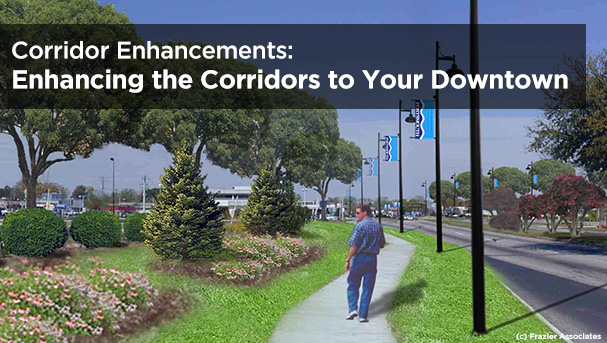
This article is the second in a series on corridors and the important role they play in Main Street revitalization. The previous article focused on the historic origins of corridors, corridor types, and functions that they serve in our communities. This article examines steps that a community can take to improve these important connectors to downtowns and provides a brief summary of some of the local regulatory and technical tools that can be used to underpin such an improvement plan.
Many of a locality’s corridors evolved organically over time as the community grew and expanded. The result may be a mix of both positive and negative elements along these important thoroughfares. If a community decides to examine them and create a plan of improvement, it should be aware of several principles that support the development of more attractive and better functioning corridors. These goals may include:
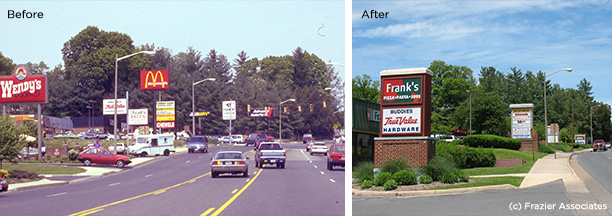
Lexington, Virginia made dramatic improvements to one of their primary entry corridors by scaling clutter and eliminating pole-mounted signs. The new ground mounted signs and landscaping along the corridor edge greatly enhanced the appearance leading to their historic downtown. Photo 1) Lexington’s East Nelson Street before the corridor improvements was reflective of many typical commercial strips. Photo 2) Improvements along East Nelson eliminated clutter, and provided new signage and landscaping.
In order to develop a community corridor improvement program, a working task force could analyze these arteries by various criteria including:
After undertaking this analysis, the group can determine the level of change and upgrade that is desirable and feasible. The following approaches go from modest improvements to more extensive and expensive redevelopments.
1. Retain Vehicular Focus & Beautify
This approach focuses on minor public improvements to include better maintenance, addition of landscaping, new gateway signage and other cost-effective ideas. In terms of the private sector, site and building improvements would focus on cosmetic upgrades such as repainting, new signage, awnings, repaving parking areas and adding landscaping. The focus on vehicular movement would be maintained and pedestrian upgrades would not be undertaken due to the primary function of the corridor.
2.Balance between Vehicular & Pedestrian Focus
This approach would recognize the opportunity to improve the pedestrian aspect of the corridor and might include connectivity upgrades, traffic calming, and pedestrian streetscape furniture in addition to the above listed beautification projects.
3.Manage Vehicles & Focus on Pedestrian
In some areas of corridors, as one approaches a downtown, there may be the opportunity to create a higher density of development that would adjust zoning classifications and provide a greater mix of uses along with structured parking if needed. With the focus on the pedestrian, the plan would include upgrades to sidewalks, pedestrian lighting, street furniture, and open space amenities among others.
4.Redevelopment
In some cases, older and outdated corridors may be ripe for a complete makeover. Often a total new vision may come from a new corridor plan or as part of a comprehensive plan update. At this level of change, one might expect road reconfiguration, private site clearance, new zoning categories and much new construction. In these instances, there is the opportunity to create a completely new image for the corridor that results in a positive experience for all users and an upgraded route to downtown.
5.Infill Redevelopment
A variation on this redevelopment concept is to undertake a new infill project that is on a smaller scale than a complete corridor makeover. As community revitalization spreads out from a successful downtown program, there are often opportunities for individual infill projects on corridors near the central business district. When this phenomenon occurs, the Main Street effort is experiencing such success that nearby parcels become more attractive to developers and downtown actually grows physically. Carefully crafted design guidelines and zoning categories can ensure that this new development contributes to the design quality of the neighboring historic core.
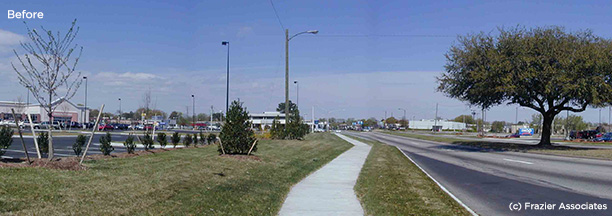
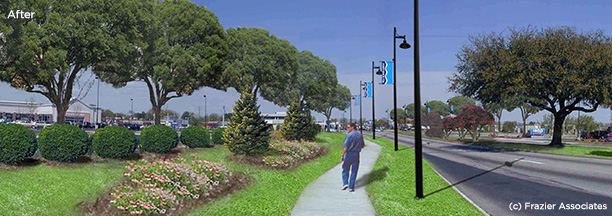
In an effort to enhance the experience of visitors and build pride in its residents, the City of Portsmouth created a Gateway & Corridor Design Manual. The manual includes recommendations for major corridor improvements such as these photosimilutation designs for new lighting, banners and landscaping along Frederick Boulevard.
Once the community has decided that corridor improvements are a priority, it is time to engage a typical planning process. Likely, the comprehensive plan has identified corridors as an issue and has created vision statement(s) in that regard. Different corridors serve different purposes and require different visions.
Use appropriate design principles that have been listed earlier to form the basis for the improvements along with an inventory and analysis of positive and negative elements in both the public and private spaces of the artery. The next step is to graphically create several options to treat the corridor and select one to develop into more detail. The plan could include any of the approaches previously discussed from minor aesthetic upgrades to complete redevelopment.
Implementing the plan requires design and engineering expertise along with in-house planning and public works departments’ participation. Frequently a planning/landscape architecture firm may create the master plan for the corridor(s) and detailed construction documents and specifications may be developed in conjunction with an engineering firm as well. If the corridor improvement program is being phased, there will also be the opportunity to evaluate and reassess the plan during and after construction.
Financing the improvements is often a mix of local tax dollars and state and/or federal transportation funds depending on the project and grant requirements. A local service tax district may be instituted as well to provide funding for continued maintenance and further improvements.
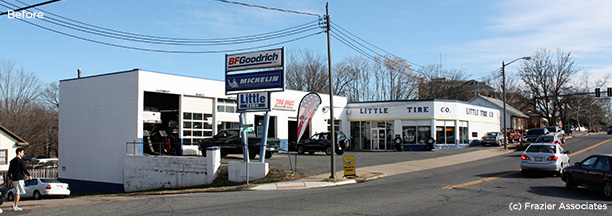
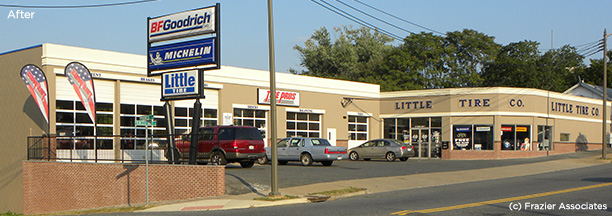
Fredericksburg, Virginia’s Economic Development Authority established a Façade Improvement Grant Program to improve the appearance along one of the City’s main gateways to downtown. The owners of the Little Tire Company took advantage of the funds to enhance the façade of their 1959 family-owned building. Photo 1) Little Tire before improvements. Photo 2) Little Tire following façade improvements
While it is difficult to generalize about the way such a plan involves the various sectors of the community, particularly due to its size, any effort needs to be broad based to succeed. Obviously, property owners, business associations, civic/neighborhood groups and citizens at large all have a stake in such an effort. From the government side, planning, neighborhood, redevelopment, economic development, tourism, public works, and traffic department/agencies may all play a part, often along with the state transportation agency. In a small community with limited planning resources, the local Main Street office may play a prominent role in such an effort while in a larger locality with more resources, the downtown staff may be more of a support organization.
There are several approaches in the development of a corridor improvement plan including regulations and incentives including technical assistance and design guidance. The most successful corridor enhancement projects likely use a combination of all of theses tools. If a new vision is a part of the planning process for a particular corridor, it is likely that the underlying zoning may not be sufficient or appropriate to create this newly desired image. It is important that this new layer line up as much as possible with the zoning so that two different concepts are not introduced to the property owner interested in making improvements. These overlay districts may also include a set of illustrated guidelines that assist the owner in making changes that reflect the new plan and vision.
The third regulatory tool for corridors could be the adoption of a form-based code which may prescribe more detailed requirements such as building form standards including massing, materials, window/wall ratios, storefront areas, signage, etc. These standards may vary according to the building type including commercial, office and residential structures. Public space standards may be developed for commercial and residential streets, urban avenues or even alleys and include such elements as pedestrian paths, landscaped areas, lighting design and levels, public signage, streetscape furniture etc. The underlying regulating plan of a form-based code would prescribe the permitted uses of parcels within a corridor and would relate to each of the building types listed above. This new tool may be mandatory code or a parallel code that goes with existing regulations. Form-based codes can be very effective in creating a new corridor or for a corridor undergoing major redevelopment but this tool may be more difficult to implement along an existing artery with most parcels already occupied by functioning structures.
These tools might include financial aids such as matching grants or low-interest loans for building and site improvements. They also may include the local municipality helping property owners getting through the permitting and review process. The incentives are usually coupled with design assistance for the property owner in the form of architectural services that are based on a set of design guidelines. A design review staff or an appointed review board normally administered these regulations. Over time, a new corridor vision can be created as property owners undertake normal maintenance or new upgrades to their buildings and sites.
As Main Street programs mature and central business districts revitalize, a corridor enhancement program is a natural next focus. Besides providing a more pleasant journey to the destination of downtown, a community’s corridors offer the opportunity for increased economic development of another important segment of the community.
William T. Frazier, AICP and Kathleen O. Frazier, AIA, are principals with Frazier Associates, a Virginia-based architecture, planning, and graphic design firm whose mission is to help preserve, revitalize and sustain communities large and small. The firm has provided design assistance to Main Street communities for over 28 years and has completed more than forty sets of design guidelines throughout the southeast United States. Learn more at www.frazierassociates.com.